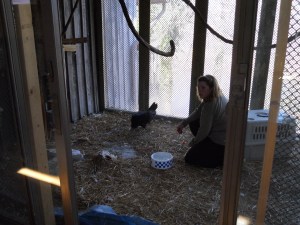It’s been a while since I’ve given an update on Einstein’s training progress, but that doesn’t mean we haven’t been working with him. In fact, Lisa has come to TreeHouse each of the last two weeks to work with him, and she plans to come for training on a regular basis this summer.
Overall, Einstein’s demeanor is vastly different from what it was last fall when he first came to Dow. The difference is partly in his behavior and partly in the way we respond to it. He can be stubborn, and he is always trying to make everything into a game, trying to manipulate our behavior through his own actions. He understands the cycle of events in which his attacking our legs causes us to walk out of the cage, then his returning to the correct perch causes us to come back in, give him a treat, and start the process over. So, he often turns it into a game in which he chases us out, then almost immediately goes back onto the perch, asking us to come back.
Of course, in a way I think it’s great that he wants to play with us and he makes up his own games. But at the same time, when we’re trying to work on getting him to go in the crate or let us put jesses on him, it’s not very conducive to a productive training session if he’s constantly trying to play tag with us. So, now we’ve changed up our strategy a bit—we hold our ground when he starts to play his games, pushing his head away with the target stick and reminding him that we’re bigger than him and he is not the dominant one.
We also hit a bit of a road block during early spring, when he suddenly became extremely territorial and aggressive. We quickly realized what was going on—it was breeding season in the wild, and our confused, captive human imprint didn’t seem to know quite what to do with himself. Once when Lisa came for training during this time, he actually flew onto the top of her head and started beating at her with his wings and trying to pull at her hair. Luckily, Lisa is pretty unfazed by anything any bird does to her. Also, I should note—although I typically refer to Einstein as “he” for the sake of convenience, we actually have no idea whether “he” is male or female. His behavior is an oddball mix of behaviors that we would typically consider “male” and “female”. During breeding season, his intense territorial aggression might lead us to believe that he is in fact male, but he also displayed nesting behavior, and he does a strange little twirling dance with his tail feathers raised, leading several of our volunteers to believe he is female. Ultimately, behavior is NEVER a reliable indicator of sex in birds—even wild birds. And a human imprint like Einstein is just extra confused and even more likely to throw you a behavioral curveball.
Anyway, breeding season is over now, so he’s gone back to his usual behavior and we’re back on track with his training. The crate that he was so terrified of when we first introduced it is still causing some problems. He isn’t really afraid of it anymore, and it is now basically a permanent fixture in his cage. I’ll often walk by and see him standing on top of it. He will also go inside the crate, but only if there’s food inside, not just because we ask him to. That’s OK, really, except that he also refuses to go all the way in if we’re in the room with him. He’ll stretch his neck in there to reach a treat, and he’ll even take a step over the threshold if we’re really patient, but he won’t go far enough in for us to shut the door. It seems that he doesn’t quite trust us—he seems to think that as soon as he goes all the way inside we’ll close the door and he’ll be trapped in there.
Of course he’s right. That is exactly our plan. But it’s only because we need him to learn that the door can be closed and he can be stuck inside and nothing earth-shattering will happen, and we won’t keep him in there forever.
Once he learns to go into the crate without making trouble, we’ll be able to focus on getting jesses on him. Jesses are leather straps that go around a bird’s ankles, allowing us to tether the bird to an anchor, sometimes on a perch stand and sometimes on our belt. When we can get him jessed up and crated up, we’ll be able to bring him along when we set up booths at events and give educational programs. We’re all pretty confident that Einstein will find that absolutely wonderful. Most of our education birds merely tolerate the crowds, but Einstein is a social bird who thinks he is human, and he loves nothing more than being the center of attention. Any time we have visitors in the education center, where his cage is, he is always right at the glass, peering through at anyone who will come down to his level.
There have been times over the past months when Einstein’s stubbornness and sporadic aggression have made working with him pretty frustrating, but most of the time it’s a lot of fun. Every day when I go in the education center, pick up the target stick and clicker and clip the pouch of treats onto my jeans, there he is on his perch or at the door, watching me with his head tilted to one side, asking me to come in and play. It’s hard not to like a bird that so obviously wants to be friends.




